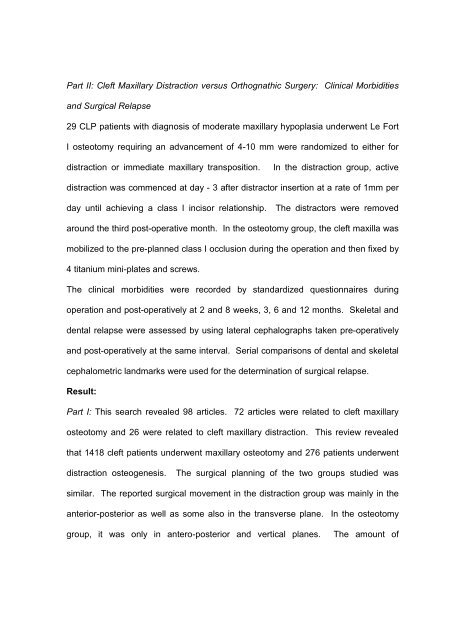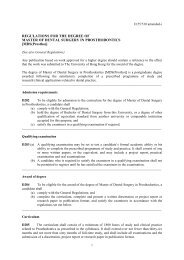Abstract Objectives: 1. To compare the surgical treatment methods of ...
Abstract Objectives: 1. To compare the surgical treatment methods of ...
Abstract Objectives: 1. To compare the surgical treatment methods of ...
Create successful ePaper yourself
Turn your PDF publications into a flip-book with our unique Google optimized e-Paper software.
Part II: Cleft Maxillary Distraction versus Orthognathic Surgery: Clinical Morbidities<br />
and Surgical Relapse<br />
29 CLP patients with diagnosis <strong>of</strong> moderate maxillary hypoplasia underwent Le Fort<br />
I osteotomy requiring an advancement <strong>of</strong> 4-10 mm were randomized to ei<strong>the</strong>r for<br />
distraction or immediate maxillary transposition.<br />
In <strong>the</strong> distraction group, active<br />
distraction was commenced at day - 3 after distractor insertion at a rate <strong>of</strong> 1mm per<br />
day until achieving a class I incisor relationship. The distractors were removed<br />
around <strong>the</strong> third post-operative month. In <strong>the</strong> osteotomy group, <strong>the</strong> cleft maxilla was<br />
mobilized to <strong>the</strong> pre-planned class I occlusion during <strong>the</strong> operation and <strong>the</strong>n fixed by<br />
4 titanium mini-plates and screws.<br />
The clinical morbidities were recorded by standardized questionnaires during<br />
operation and post-operatively at 2 and 8 weeks, 3, 6 and 12 months. Skeletal and<br />
dental relapse were assessed by using lateral cephalographs taken pre-operatively<br />
and post-operatively at <strong>the</strong> same interval. Serial comparisons <strong>of</strong> dental and skeletal<br />
cephalometric landmarks were used for <strong>the</strong> determination <strong>of</strong> <strong>surgical</strong> relapse.<br />
Result:<br />
Part I: This search revealed 98 articles. 72 articles were related to cleft maxillary<br />
osteotomy and 26 were related to cleft maxillary distraction. This review revealed<br />
that 1418 cleft patients underwent maxillary osteotomy and 276 patients underwent<br />
distraction osteogenesis. The <strong>surgical</strong> planning <strong>of</strong> <strong>the</strong> two groups studied was<br />
similar. The reported <strong>surgical</strong> movement in <strong>the</strong> distraction group was mainly in <strong>the</strong><br />
anterior-posterior as well as some also in <strong>the</strong> transverse plane. In <strong>the</strong> osteotomy<br />
group, it was only in antero-posterior and vertical planes. The amount <strong>of</strong>





